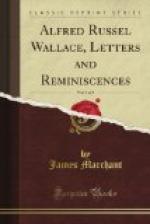[Illustration: A.R. Wallace Singapore, 1862]
One or two points in the following letters recall certain contrasts similar to those already drawn between Darwin’s impression of places and people and those made on the mind of Wallace by practically the same conditions. A typical instance is found in their estimate of the life and work of the missionaries whom they met and from whom they received the warmest hospitality. Their experience included both Protestant and Roman Catholic, and from Darwin’s account the former appeared to him to have the more civilising effect on the people, not only from a religious but also from the economic and industrial points of view.
In the “Journal” (p. 419) we find a detailed account of a visit to the missionary settlement at Waimate, New Zealand. After describing the familiar English appearance of the whole surroundings, he adds: “All this is very surprising when it is considered that five years ago nothing but the fern flourished here. Moreover, native workmanship, taught by these missionaries, has effected this change—the lesson of the missionary is the enchanter’s wand. The house had been built, the windows framed, the fields ploughed, and even the trees grafted, by the New Zealander. When I looked at the whole scene it was admirable. It was not that England was brought vividly before my mind; ... nor was it the triumphant feeling at seeing what Englishmen could effect; but rather the high hopes thus inspired for the future progress of this fine island.”
No such feeling was inspired by the conditions surrounding the Roman Catholic missionaries whom he met from time to time. In an earlier part of the “Journal” he records an evening spent with one living in a lonely place in South America who, “coming from Santiago, had contrived to surround himself with some few comforts. Being a man of some little education, he bitterly complained of the total want of society. With no particular zeal for religion, no business or pursuit, how completely must this man’s life be wasted.”




